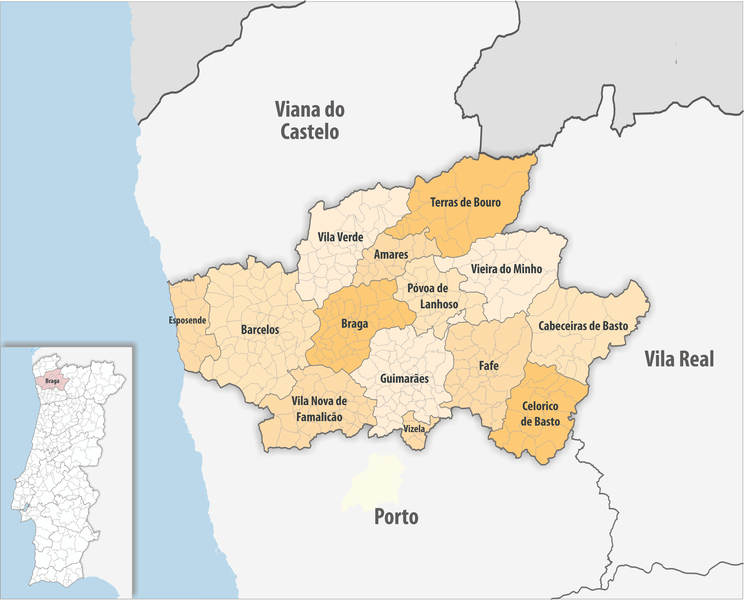|
Campo E Tamel (São Pedro Fins)
Campo e Tamel (São Pedro Fins) is a civil parish In England, a civil parish is a type of administrative parish used for local government. It is a territorial designation which is the lowest tier of local government below districts and counties, or their combined form, the unitary authorit ... in the municipality of Barcelos, Portugal. It was formed in 2013 by the merger of the former parishes Campo and Tamel (São Pedro Fins). The population in 2011 was 1,521,Instituto Nacional de Estatística (INE) Census 2011 results according to the 2013 administrative division of Portugal in an area of 4.81 km². References [...More Info...] [...Related Items...] OR: [Wikipedia] [Google] [Baidu] |
Cávado (intermunicipal Community)
The Comunidade Intermunicipal do Cávado () is an administrative division in northern Portugal. It was created in 2008. It is also a NUTS3 subregion of the Norte Region. The seat of the intermunicipal community is Braga, Norte. Cávado comprises part of the former Braga District. The population in 2011 was 410,169, in an area of , which makes it one of the most densely populated subregions of Portugal. Currently, as of 2021, it has 416.679 inhabitants and a population density of 351 per square kilometres. Its name is derived from the Cávado River that drains a large part of its territory. It borders the intermunicipal community of Ave and the Metropolitan Area of Porto to the south, Alto Tâmega to the east, Alto Minho to the north and the Atlantic Ocean The Atlantic Ocean is the second-largest of the world's five oceans, with an area of about . It covers approximately 20% of Earth's surface and about 29% of its water surface area. It is known to separate the " Old Worl ... [...More Info...] [...Related Items...] OR: [Wikipedia] [Google] [Baidu] |
Braga District
The district of Braga ( pt, Distrito de Braga ) is a district in the northwest of Portugal. The district capital is the city of Braga, and it is bordered by the district of Viana do Castelo in the north, Vila Real in the east, Spain ( Galicia) in the northeast and Porto in the south. Its area is and it has a population of 831,368. Municipalities The district comprises 14 municipalities: * Amares * Barcelos * Braga * Cabeceiras de Basto * Celorico de Basto * Esposende * Fafe * Guimarães * Póvoa de Lanhoso * Terras de Bouro * Vieira do Minho * Vila Nova de Famalicão * Vila Verde * Vizela Geography The district of Braga has a very rugged terrain, dominated by high altitudes to the east, close to the Spanish border and the border with the Vila Real district, and going down towards the western coast, cutting through the valleys of several rivers that flow from the north-east to the south-west. The highest altitudes are found in the Serra Amarela (1,361m), on the border wi ... [...More Info...] [...Related Items...] OR: [Wikipedia] [Google] [Baidu] |
Barcelos, Portugal
Barcelos () is a city and a municipality in Braga District in the Minho Province, in the north of Portugal. The population in 2011 was 120,391, in an area of 378.90 km2. With 60 parishes, it is the municipality with the highest number of parishes in the country. It is one of the growing municipalities in the country, and is well known by its textile and adobe industries, as well as its horseback riding events and "figurado" style of pottery, which are comical figurines with accentuated features of farmers, folk musicians, and nativity scene characters. Barcelos is part of the UNESCO Creative Cities Network as a Crafts and Folk Art City. History Originally a Roman settlement, it expanded and became the seat of the First Duke of Bragança in the 15th century. The palace of the Dukes of Bragança was destroyed by an earthquake in 1755 and is now an open-air museum. The town is on the Portuguese Way, a Christian pilgrimage route connecting the Camino de Santiago. Constru ... [...More Info...] [...Related Items...] OR: [Wikipedia] [Google] [Baidu] |
Freguesia (Portugal)
''Freguesia'' (), usually translated as "parish" or "civil parish", is the third-level administrative subdivision of Portugal, as defined by the 1976 Constitution. It is also the designation for local government jurisdictions in the former Portuguese overseas territories of Cape Verde and Macau (until 2001). In the past, was also an administrative division of the other Portuguese overseas territories. The ''parroquia'' in the Spanish autonomous communities of Galicia and Asturias is similar to a ''freguesia''. A ''freguesia'' is a subdivision of a ''município'' (municipality). Most often, a parish takes the name of its seat, which is usually the most important (or the single) human agglomeration within its area, which can be a neighbourhood or city district, a group of hamlets, a village, a town or an entire city. In cases where the seat is itself divided into more than one parish, each one takes the name of a landmark within its area or of the patron saint from the usually cot ... [...More Info...] [...Related Items...] OR: [Wikipedia] [Google] [Baidu] |
Barcelos Municipality, Portugal
Barcelos () is a city and a municipality in Braga District in the Minho Province, in the north of Portugal. The population in 2011 was 120,391, in an area of 378.90 km2. With 60 parishes, it is the municipality with the highest number of parishes in the country. It is one of the growing municipalities in the country, and is well known by its textile and adobe industries, as well as its horseback riding events and "figurado" style of pottery, which are comical figurines with accentuated features of farmers, folk musicians, and nativity scene characters. Barcelos is part of the UNESCO Creative Cities Network as a Crafts and Folk Art City. History Originally a Roman settlement, it expanded and became the seat of the First Duke of Bragança in the 15th century. The palace of the Dukes of Bragança was destroyed by an earthquake in 1755 and is now an open-air museum. The town is on the Portuguese Way, a Christian pilgrimage route connecting the Camino de Santiago. Constru ... [...More Info...] [...Related Items...] OR: [Wikipedia] [Google] [Baidu] |


